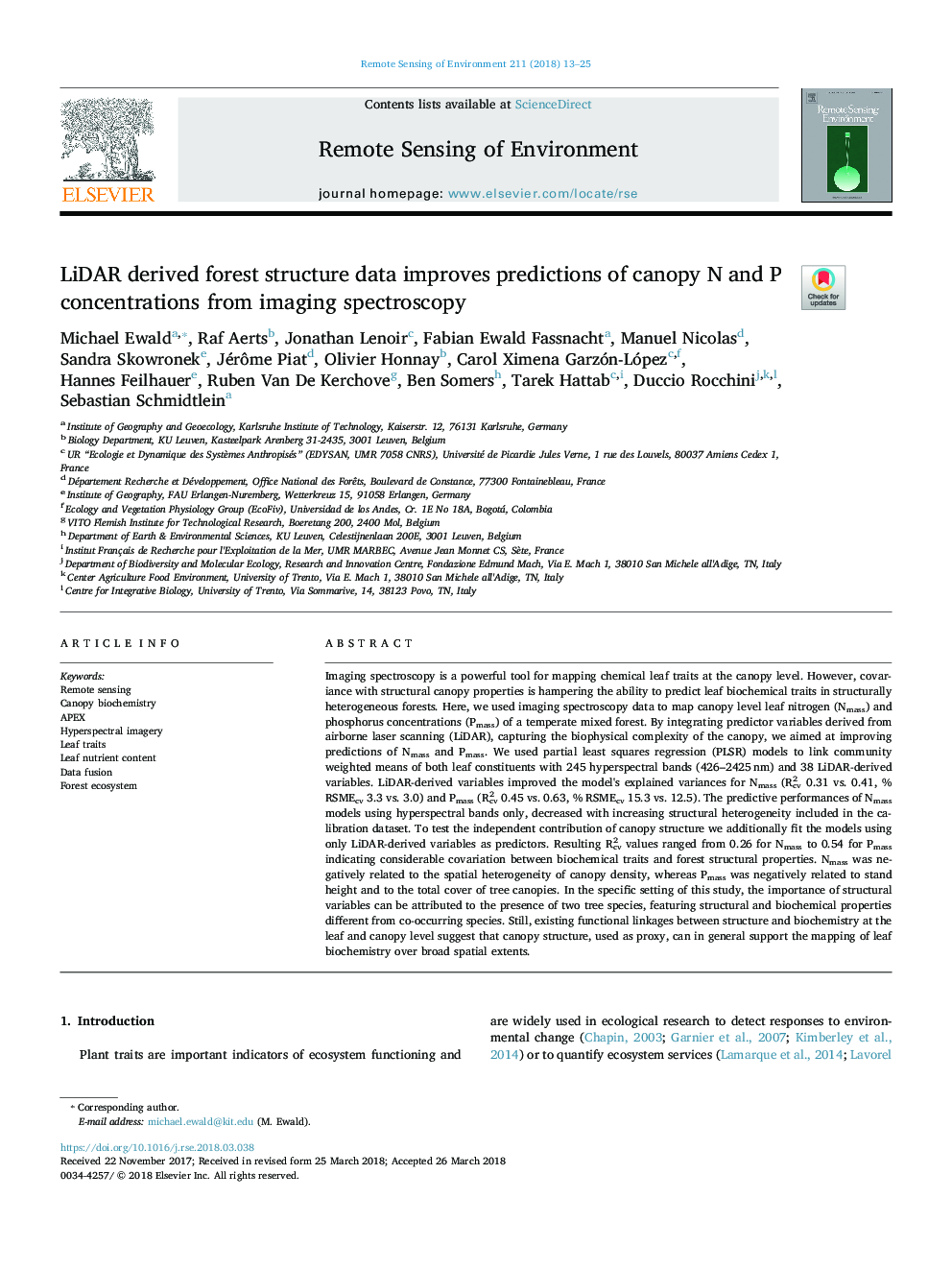| کد مقاله | کد نشریه | سال انتشار | مقاله انگلیسی | نسخه تمام متن |
|---|---|---|---|---|
| 8866546 | 1621189 | 2018 | 13 صفحه PDF | دانلود رایگان |
عنوان انگلیسی مقاله ISI
LiDAR derived forest structure data improves predictions of canopy N and P concentrations from imaging spectroscopy
دانلود مقاله + سفارش ترجمه
دانلود مقاله ISI انگلیسی
رایگان برای ایرانیان
کلمات کلیدی
موضوعات مرتبط
مهندسی و علوم پایه
علوم زمین و سیارات
کامپیوتر در علوم زمین
پیش نمایش صفحه اول مقاله

چکیده انگلیسی
Imaging spectroscopy is a powerful tool for mapping chemical leaf traits at the canopy level. However, covariance with structural canopy properties is hampering the ability to predict leaf biochemical traits in structurally heterogeneous forests. Here, we used imaging spectroscopy data to map canopy level leaf nitrogen (Nmass) and phosphorus concentrations (Pmass) of a temperate mixed forest. By integrating predictor variables derived from airborne laser scanning (LiDAR), capturing the biophysical complexity of the canopy, we aimed at improving predictions of Nmass and Pmass. We used partial least squares regression (PLSR) models to link community weighted means of both leaf constituents with 245 hyperspectral bands (426-2425â¯nm) and 38 LiDAR-derived variables. LiDAR-derived variables improved the model's explained variances for Nmass (R2cv 0.31 vs. 0.41, % RSMEcv 3.3 vs. 3.0) and Pmass (R2cv 0.45 vs. 0.63, % RSMEcv 15.3 vs. 12.5). The predictive performances of Nmass models using hyperspectral bands only, decreased with increasing structural heterogeneity included in the calibration dataset. To test the independent contribution of canopy structure we additionally fit the models using only LiDAR-derived variables as predictors. Resulting R2cv values ranged from 0.26 for Nmass to 0.54 for Pmass indicating considerable covariation between biochemical traits and forest structural properties. Nmass was negatively related to the spatial heterogeneity of canopy density, whereas Pmass was negatively related to stand height and to the total cover of tree canopies. In the specific setting of this study, the importance of structural variables can be attributed to the presence of two tree species, featuring structural and biochemical properties different from co-occurring species. Still, existing functional linkages between structure and biochemistry at the leaf and canopy level suggest that canopy structure, used as proxy, can in general support the mapping of leaf biochemistry over broad spatial extents.
ناشر
Database: Elsevier - ScienceDirect (ساینس دایرکت)
Journal: Remote Sensing of Environment - Volume 211, 15 June 2018, Pages 13-25
Journal: Remote Sensing of Environment - Volume 211, 15 June 2018, Pages 13-25
نویسندگان
Michael Ewald, Raf Aerts, Jonathan Lenoir, Fabian Ewald Fassnacht, Manuel Nicolas, Sandra Skowronek, Jérôme Piat, Olivier Honnay, Carol Ximena Garzón-López, Hannes Feilhauer, Ruben Van De Kerchove, Ben Somers, Tarek Hattab, Duccio Rocchini,